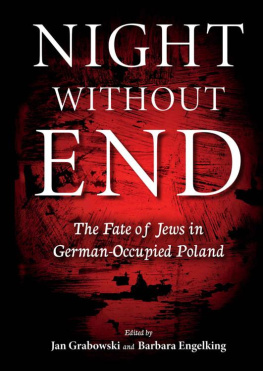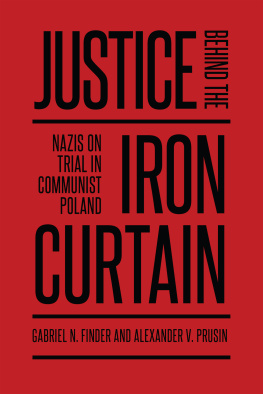NIGHT WITHOUT END
NIGHT WITHOUT END
THE FATE OF JEWS IN
GERMAN-OCCUPIED POLAND

EDITED BY
Jan Grabowski and Barbara Engelking

The Center for Research on the Holocaust in Poland
INDIANA UNIVERSITY PRESS
This book is a publication of
Indiana University Press
Office of Scholarly Publishing
Herman B Wells Library 350
1320 East 10th Street
Bloomington, Indiana 47405 USA
iupress.org
Yad VashemThe World Holocaust Remembrance Center
P.O.B. 3447, Jerusalem, 9103401, Israel
www.yadvashem.org
2022 by Yad Vashem and Indiana University Press
All rights reserved
No part of this book may be reproduced or utilized in any form or by any means, electronic or mechanical, including photocopying and recording, or by any information storage and retrieval system, without permission in writing from the publisher. The paper used in this publication meets the minimum requirements of the American National Standard for Information SciencesPermanence of Paper for Printed Library Materials, ANSI Z39.481992.
Manufactured in the United States of America
First printing 2022
Library of Congress Cataloging-in-Publication Data
Names: Engelking, Barbara, editor. | Grabowski, Jan, editor.
Title: Night without end : the fate of Jews in German-occupied Poland / edited by Jan Grabowski and Barbara Engelking ; translated from Polish by Anna Brzostowska, Jerzy Giebutowski, Jan Grabowski, Elbieta Olender-Dmowska, and Tomasz Frydel.
Other titles: Dalej jest noc. English.
Description: Bloomington, Indiana : Indiana University Press, [2022] | Includes bibliographical references and index.
Identifiers: LCCN 2022000114 (print) | LCCN 2022000115 (ebook) | ISBN 9780253062857 (hardback) | ISBN 9780253062864 (paperback) | ISBN 9780253062871 (ebook)
Subjects: LCSH: Holocaust, Jewish (1939-1945)Poland. | PolandHistoryOccupation, 1939-1945. | JewsPersecutionsPoland. | PolandEthnic relations. | AntisemitismPoland. | World War, 1939-1945AtrocitiesPoland. | PolandHistoryOccupation, 1939-1945.
Classification: LCC DS134.55 .D3513 2022 (print) | LCC DS134.55 (ebook) | DDC 940.53/1809438dc23/eng/20220406
LC record available at https://lccn.loc.gov/2022000114
LC ebook record available at https://lccn.loc.gov/2022000115
The research leading to the publication of this book has been funded by the Ministry of Science and Higher Education (Poland, grant 12H/13/0484/82); the Social Sciences and Humanities Research Council of Canada (Canada, grant 8945330-2012-0018); and the Conference on Jewish Material Claims Against Germany (grant SO42-14283).
Maps created by Zbigniew Gaza.
Translated from Polish by Anna Brzostowska, Jerzy Giebutowski, Jan Grabowski, Elbieta Olender-Dmowska, and Tomasz Frydel. Language editing: Leah Goldstein.
Originally published by the Polish Center for the Holocaust Research at the Polish Academy of Science as Dalej jest noc: Losy ydw w wybranych powiatach okupowanej Polski, Tom 1, 2 2018, Centrum Badan nad Zaglada Zydow
CONTENTS
INTRODUCTION
Historians of the Holocaust often refer to World War II as the war against the Jews. This term is particularly true in the case of Polish Jewsthe largest Jewish community in prewar Europe. Out of more than approximately three million Jewish citizens of the Second Polish Republic who found themselves under German rule (excluding those who survived in the Soviet Union), no more than 1.52 percent survived the war. Despite decades of work, we still do not know enoughand sometimes we know woefully littleabout what happened during those horrifying years. This book is much less about interpretations; it is driven, most of all, by our desire to know more, to shed light on events that have been, and that should have never been, largely forgotten, pushed aside, belittled, or relativized.
This book is a result of the cooperation between a group of scholars affiliated with the Polish Center for Holocaust Research at the Institute of Philosophy and Sociology of the Polish Academy of Science in Warsaw. The studies presented here are the fruits of several years of research on the history of the Holocaust in the Polish provinces. We have examined this issue for quite some time, resulting in the publication of two books by the center devoted entirely to this subject: Prowincja noc (2007) and Zarys krajobrazu (2011). Our current studies summarize the next phase in our work, inspired directly by earlier research conducted on the history of Dbrowa Tarnowska County.methodological approach. This time, however, we used this approach as a framework for a much broader investigation, and as a result, we are able to offer the reader a closer look at several selected counties of occupied Poland.
The volume contains eight studies, each one devoted to a different area of occupied Poland. Each study begins with an overview of the situation of the Jewish population prior to 1939 and its prewar relations with the rest of Polish society. These relations evolved along different trajectories, which usually were tied to the makeup of the local political scene. In the eastern part of the country, the overlapping Polish-Ukrainian conflict made Polish-Jewish relations even more complex. After the outbreak of World War II, two of the selected areas (Bielsk and Zoczw) found themselves under Soviet occupation, while the others were occupied by the Germans. After June 22, 1941, all counties described in the book fell under German rule, with all its consequences. It was the so-called first phase of the Holocaust, marked by branding regulations, terror, robbery, death through forced labor, and enslavement in the ghettos. The two eastern areas also went through a wave of pogroms and mass executions associated with the arrival of the Germans. Soon after, the second phase of the Holocaustor the liquidations of the ghettosbegan. At this point, the great majority of the Jews living in the studied areas were deported to one of the five extermination camps established by the Germans in Poland. During the liquidation actions, a part of the Jewish population was murdered in situ, in the liquidated ghettos, while some (according to our count, around 10 percent) managed to flee. The fate of these refugees is what we call the third phase of the Holocaust, and this is the part that finds itself at the core of our accounts: the strategies of survival of Jews fighting for their lives outside the ghettos, on the Aryan side, among the Christian population. Their struggle lasted until liberation by Soviet forces.
It was during this third phase (labeled by the Germans as the Judenjagd , or hunt for the Jews) that the attitude of the Polish (or in the case of two counties, Ukrainian and Belorussian) population toward Jewish refugees became a factor that either greatly increased or substantially diminished their chances of survival. The beginning of the discussion of the scale of Polish participation in the events under discussion was marked by the publication of Jan Grosss book Neighbors in 2000. In the two decades or so since then, the debate has continued among Polish scholars and the media, with recourse not only to pure historical reasoning but also invoking emotional and political arguments. This has made us acutely aware of the importance of in-depth research and analyses that might produce reliable data, both quantitative and qualitative. This book has been written with the hope of providing solid data, which would allow future discussions to be based on a firm factual foundation.
Next page









